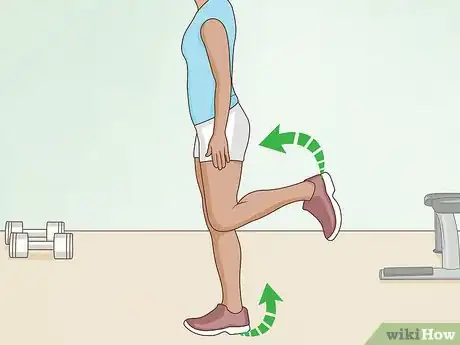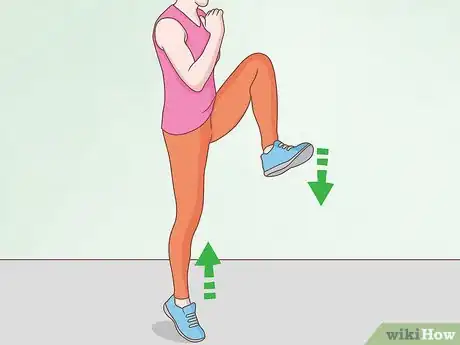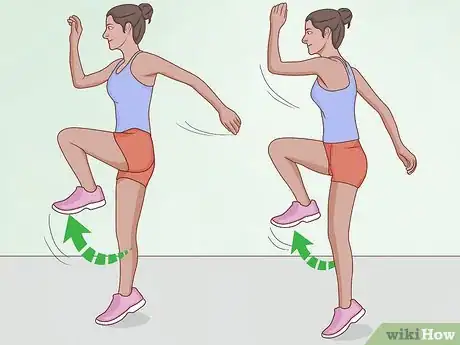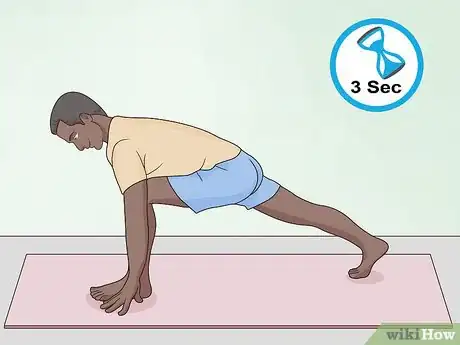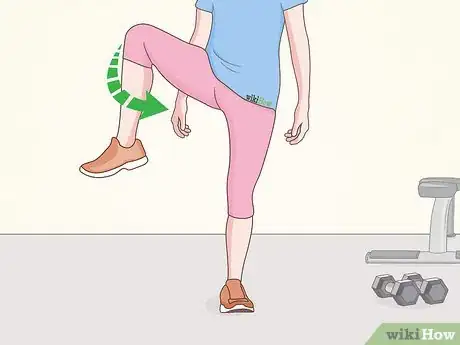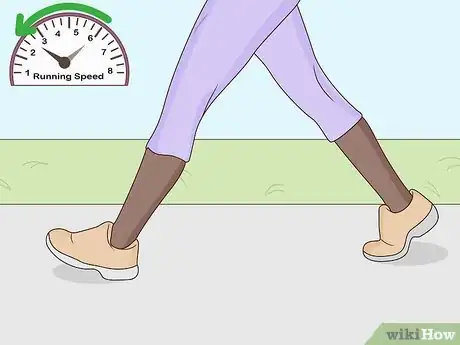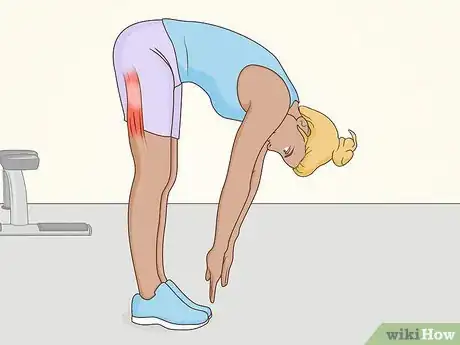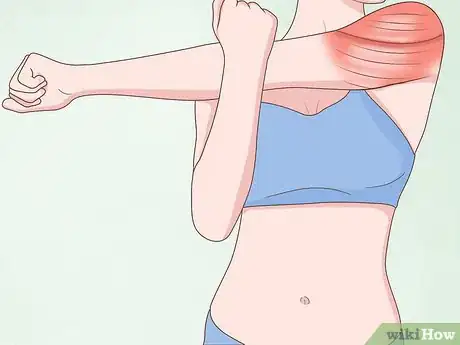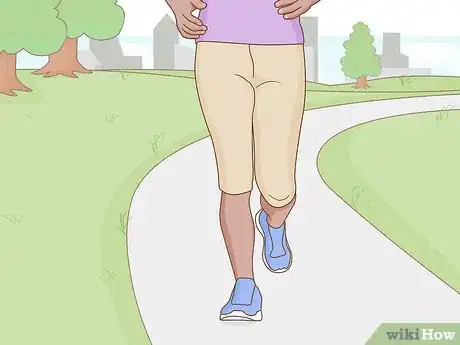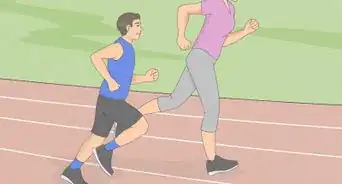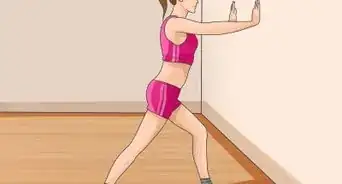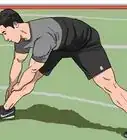This article was co-authored by Kai Ng. Kai Ng is a USATF and RRCA Certified Running Coach at Run Coach Kai. Kai has competed in over 55 races and over 15 marathons, and has trained with 16x USA and World record holder Patti Catalano Dillonso. He specializes in coaching runners of all levels and showing people that everyone can be a runner. Kai is committed to helping his clients reach their goals by showing them how to run with proper form and holding them accountable to train consistently.
There are 8 references cited in this article, which can be found at the bottom of the page.
This article has been viewed 67,295 times.
You're about to go on a run. Maybe it's a sprint, maybe it's a marathon, or maybe it's just a jog around the neighborhood. In any case, a dynamic warm up will increase the power of your muscles and enable you to run further without pain. After the run, make sure to slow down gradually and perform long, static stretches for any muscles that feel tense.
Steps
Warming Up Before a Run
-
1Minimize static stretches before exercise. Many people use the words “stretch" and “warm up" interchangeably, but they serve different purposes. Stretches involve holding your muscles in place in a lengthened position. This loosens and relaxes your muscle, which may reduce running efficiency. Instead, prepare for a workout by warming up with the exercises below, or anything that gets your muscles moving.[1]
- Many athletes refer to warm ups as "dynamic stretches" or "active stretches," as opposed to "static stretches" where you hold a muscle still.[2]
- Despite what you may have heard, static stretches probably do not help prevent injury.[3] Over-stretching with static stretches may even increase the risk of cramps and pulled muscles.
EXPERT TIPTyler Courville is a brand ambassador for Salomon Running. He has run in 10 ultra and mountain races across the United States and Nepal, and won the 2018 Crystal Mountain Marathon.Professional Runner
 Tyler Courville
Tyler Courville
Professional RunnerIn addition to dynamic stretches, you can try using a foam roller. Tyler Courville, ultra and mountain runner, adds: “I'm a proponent of foam rolling. I do that before a run, after a run, periodically throughout the day and before bed. You can do it anytime and don't have to worry about straining something."
-
2Perform heel flicks. Jog forward at a slow pace. As you run, bring your knee up in line with your hips, and bring your foot back to touch your bottom. Repeat this motion with alternating legs. You may gradually increase your running speed, but don't go beyond a moderate pace.[4]
- This exercise — along with the high knees, power skips, and lunges below — warm up all the muscles of your lower body. This is useful for all runs, but put extra focus on them before a long-distance run, as cramps are a higher danger.
Advertisement -
3Add high knees to your warm up. As you run at a slow to moderate pace, bring your knee up above your waistline. This is easier if you hold your hands and forearms out horizontally from your body.
-
4Learn power skips. While jogging forward, start to skip with the aim of jumping as high as you can on each skip. Drive one knee up as high as you can with each jump, and lift the arm opposite that knee up above your ahead as well. Try to keep the skipping smooth, and aim for height rather than forward speed.
-
5Practice your lunges. Stretch your leg out and plant in on the ground in front of you, with your knee behind your toes. Slowly lower your body until your can easily touch the ground with your hands. Hold this for three seconds and return to a standing position. Repeat on alternate sides.[5]
- Lunges can be dynamic and static stretches depending on how quickly you lunge and how long you hold the position.
-
6Lie on your back and kick. Straight-legged scissors kicks prepare your legs for explosive movement, while "running" or "cycling" in the air warm up the whole suite of leg muscles.
-
7"Open the gate." This stretch reduces tension in your groin and thighs, which is important for long-distance running but not too relevant for sprints. To do this, stand on one leg and lift your other knee to hip level. Rotate the raised leg out away from your body, feeling the stretch in your groin. Now "close the gate" by returning the knee in front of you before lowering your leg.[6] Repeat with alternating legs.
-
8Get your heart rate up. For any type of run, increasing your heart rate first will reduce lactic acid buildup, helping you run for longer with less pain. If you're blood's not pumping yet, finish up with some jumping jacks or jogging in place.
- This step is especially important for sprints. Before a sprinting race, try warming up with five 40 meter sprints back and forth.
Stretching After a Run
-
1Slow down gradually after a run. If you've been running all-out, don't stop abruptly. Instead, slow down your running speed until you eventually reach a walking pace. This helps your muscles expel lactic acid, and helps prevent muscle cramps.EXPERT TIPTyler Courville is a brand ambassador for Salomon Running. He has run in 10 ultra and mountain races across the United States and Nepal, and won the 2018 Crystal Mountain Marathon.Professional Runner

 Tyler Courville
Tyler Courville
Professional RunnerTyler Courville, ultra and mountain runner, adds: “After a run I go straight back to the foam roller first. After that, I really like to do some yoga, usually something that focuses on the glutes and hips because that's where I get tight from my running."
-
2Stretch your quads. Now is the time for slow, deep static stretches to help your muscles relax.[7] Begin with your legs, standing on one foot and holding your ankle back against your bottom with one hand. This stretches the quad (front thigh) muscle on the leg you're holding. Hold for twenty seconds, then repeat with the other leg.[8]
- In general, try to hold each static stretch below for roughly twenty seconds.
-
3Touch your toes to stretch your hamstring. This is the muscle on the back of your thigh, which tends to get especially tense while running. Try to touch your toes while standing up or seated with your legs outstretched. Reach across your body to touch the foot with the opposite arm, then repeat on your other side.[9]
- Don't force this past mild discomfort, or you could tear something. Your flexibility will improve over time if you keep stretching.[10]
-
4Stretch your shoulders. Although they aren't under as much stress as your legs, your shoulders do tend to tense up when you run. Bring one arm across your chest, holding it with the other hand. Hold twenty seconds, then repeat with the other arm.
-
5Stick to light exercise during next-day soreness. If you're sore the next day, your muscles need a little time to repair before they're back in top condition. A light jog or other light exercise can speed this up. That said, this delayed soreness is not due to lactic acid, so vigorous exercise will not make it go away, and will likely make it worse.[11] Give yourself a rest if you're feeling pain.
Expert Q&A
-
QuestionWhat can you do to increase foot control and strength?
 Kai NgKai Ng is a USATF and RRCA Certified Running Coach at Run Coach Kai. Kai has competed in over 55 races and over 15 marathons, and has trained with 16x USA and World record holder Patti Catalano Dillonso. He specializes in coaching runners of all levels and showing people that everyone can be a runner. Kai is committed to helping his clients reach their goals by showing them how to run with proper form and holding them accountable to train consistently.
Kai NgKai Ng is a USATF and RRCA Certified Running Coach at Run Coach Kai. Kai has competed in over 55 races and over 15 marathons, and has trained with 16x USA and World record holder Patti Catalano Dillonso. He specializes in coaching runners of all levels and showing people that everyone can be a runner. Kai is committed to helping his clients reach their goals by showing them how to run with proper form and holding them accountable to train consistently.
Certified Running Coach You can put a few marbles on the ground. Then pick them up with your toes and put them in a cup.
You can put a few marbles on the ground. Then pick them up with your toes and put them in a cup. -
QuestionWhy doing deep squats is not beneficial for runners?
 Kai NgKai Ng is a USATF and RRCA Certified Running Coach at Run Coach Kai. Kai has competed in over 55 races and over 15 marathons, and has trained with 16x USA and World record holder Patti Catalano Dillonso. He specializes in coaching runners of all levels and showing people that everyone can be a runner. Kai is committed to helping his clients reach their goals by showing them how to run with proper form and holding them accountable to train consistently.
Kai NgKai Ng is a USATF and RRCA Certified Running Coach at Run Coach Kai. Kai has competed in over 55 races and over 15 marathons, and has trained with 16x USA and World record holder Patti Catalano Dillonso. He specializes in coaching runners of all levels and showing people that everyone can be a runner. Kai is committed to helping his clients reach their goals by showing them how to run with proper form and holding them accountable to train consistently.
Certified Running Coach Runners should take good care of their knees and not overuse them by doing deep squats. Runners shouldn't do squats past 90 degrees. They should stop when their thighs or quads are parallel to the ground.
Runners should take good care of their knees and not overuse them by doing deep squats. Runners shouldn't do squats past 90 degrees. They should stop when their thighs or quads are parallel to the ground. -
QuestionHow do I know if I'm exercising too much?
 Community AnswerIf you're having extreme soreness after every workout, then it could be a sign that you're overdoing it. Your body needs the proper amount of time to heal in between your work outs, so it might be a good idea to only work out every other day.
Community AnswerIf you're having extreme soreness after every workout, then it could be a sign that you're overdoing it. Your body needs the proper amount of time to heal in between your work outs, so it might be a good idea to only work out every other day.
Warnings
- Stop immediately if you feel pain while stretching. You should not feel anything beyond a short twinge. If stretching caused serious pain, cancel your run.⧼thumbs_response⧽
References
- ↑ https://www.nhs.uk/live-well/exercise/stretch-before-exercising/
- ↑ Kai Ng. Certified Running Coach. Expert Interview. 12 February 2021.
- ↑ http://journals.lww.com/cjsportsmed/Abstract/1999/10000/Stretching_Before_Exercise_Does_Not_Reduce_the.7.aspx
- ↑ https://www.youtube.com/watch?v=3N9TzdwAFHw
- ↑ Kai Ng. Certified Running Coach. Expert Interview. 12 February 2021.
- ↑ http://www.healthline.com/health/exercise-fitness/essential-groin-stretches#4
- ↑ Kai Ng. Certified Running Coach. Expert Interview. 12 February 2021.
- ↑ https://www.nhs.uk/live-well/exercise/how-to-stretch-after-a-run/
- ↑ https://www.youtube.com/watch?v=f3dl-Jj53wQ
About This Article
Stretching before and after running can help you exercise without pain. Before you run, do dynamic stretches, like jogging with your knees in line with your hips or bringing your foot back to touch your bottom. You can also try some high knees, skips, and lunges. After your run, try some slow, deep, static stretches to help your muscles relax. Try standing on 1 foot and holding your ankle back against your bottom with 1 hand to stretch your quad. You can also touch your toes to stretch your hamstrings. Hold each static stretch for 20 seconds. To learn how to exercise if your muscles are sore, keep reading!


